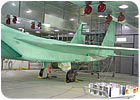Chromate-Free Corrosion Protection
Research on UV-curable coatings containing corrosion inhibiting compounds is showing promising results as an environmentally friendly replacement for chromated corrosion coatings.

 Coating systems used for military aircraft typically employ a hexavalent chromium (Cr(VI)) conversion coating in direct contact with the metallic substrate, a strontium chromate primer over the conversion coating, and a topcoat over the primer. However, chromium has been identified as a human carcinogen that can significantly increase the risk of lung cancer. As a result, Cr(VI)-based coatings are being phased out - but finding a suitable replacement has proved challenging.
Coating systems used for military aircraft typically employ a hexavalent chromium (Cr(VI)) conversion coating in direct contact with the metallic substrate, a strontium chromate primer over the conversion coating, and a topcoat over the primer. However, chromium has been identified as a human carcinogen that can significantly increase the risk of lung cancer. As a result, Cr(VI)-based coatings are being phased out - but finding a suitable replacement has proved challenging.
With funding from the Strategic Environmental Research and Development Program, researchers at the University of Missouri-Rolla (UMR), Rolla, MO, Boeing Phantom Works, St. Louis, MO, and Light Curable Coatings, Cleveland, OH, are developing environmentally friendly alternatives. The project, which began in May 2006, focuses on a two-layer coating system, including a non-chromate conversion coating layer and an ultraviolet (UV) light curable, self-priming coating containing nontoxic corrosion inhibiting materials (see Figure 1).
Previous efforts to replace the chromated corrosion coatings - in particular chromate primers - with more benign materials have had some success. For example, a chromate-free primer developed as part of a previous UMR-Boeing effort that has been commercialized by Deft Industrial Finishes is now being used on the U.S. Air Force fleet of F-15s. However, non-chromate primers and topcoats require a significant amount of time to cure and still contain undesirable volatile organic compounds (VOCs) and hazardous air pollutants (HAPs). In contrast, UV- curable systems typically do not contain VOCs or HAPs and can be completely cured within seconds.
Incorporating environmentally benign, corrosion inhibiting compounds into UV-curable coatings is an attractive alternative to the existing systems, as it would reduce the complexity of the coating system by combining the primer and topcoat into a single layer while at the same time eliminating VOCs. When used with a non-chromate conversion coating, an environmentally friendly corrosion coating system would be obtained.

The coatings are deposited from aqueous solutions containing cerium chloride using processing technology that is very similar to that currently used for the chromate system. To date, both a current-driven (non-spontaneous electrolytic) and spontaneous (immersion, spray, etc.) process have been developed (see Figure 2). The cerium oxide coatings are deposited on the aluminum alloy surface by an electrochemically driven precipitation process. Typically, the coatings are 100 to 500 nanometers thick with a characteristic grain size of a few nanometers in diameter. Depositions are achieved in less than 15 minutes and use commercially available materials and equipment, making the overall process compatible with industrial operations such as those employed by current aircraft manufacturers.
Coatings that result from these processes are composed mostly of cerium oxide/hydroxide phases. The operating parameters and conditions used to deposit the coating significantly influence the quality and performance of the deposited films. Three critical steps in producing the cerium oxide conversion coatings are surface preparation and cleaning, precipitation and coating formation, and post-deposition treatment and sealing. Studies to improve and optimize these critical steps will be conducted during the project, along with integration of the CeCC with the UV-curable coatings.

 Important formulation factors for required flexibility in solvent-free, UV-curable aerospace coatings include oligomer glass transition temperature, oligomer molecular weight, monomer and oligomer functionality, monomer glass transition temperature, ratios of components, pigmentation efficiency, and formulation additives. Many of the same factors are important for solvent-free UV curable military coatings with a low gloss appearance. Low gloss is dependent on the filler combinations, monomer and oligomer functionality, ratios of components, reactivity, cure parameters, and additives. UV-curable monomers and oligomers are being evaluated to determine the best balance of flexibility, impact resistance and fluid resistance properties. Other important properties such as viscosity and surface hardness are also being investigated. Aliphatic urethane acrylates are the focus of much of the UV development work.
Important formulation factors for required flexibility in solvent-free, UV-curable aerospace coatings include oligomer glass transition temperature, oligomer molecular weight, monomer and oligomer functionality, monomer glass transition temperature, ratios of components, pigmentation efficiency, and formulation additives. Many of the same factors are important for solvent-free UV curable military coatings with a low gloss appearance. Low gloss is dependent on the filler combinations, monomer and oligomer functionality, ratios of components, reactivity, cure parameters, and additives. UV-curable monomers and oligomers are being evaluated to determine the best balance of flexibility, impact resistance and fluid resistance properties. Other important properties such as viscosity and surface hardness are also being investigated. Aliphatic urethane acrylates are the focus of much of the UV development work.


A chromate-free primer developed as part of a previous
UMR-Boeing effort that has been commercialized by
Deft Industrial Finishes is now being used on the U.S.
Air Force fleet of F-15s.

Figure 1. A schematic representation (not to scale) showing (a) the three layers of a conventional chromate-containing corrosion protection system
and (b) the two layer technology in the system being developed by the UMR-Boeing-Light Curable Coatings team.
With funding from the Strategic Environmental Research and Development Program, researchers at the University of Missouri-Rolla (UMR), Rolla, MO, Boeing Phantom Works, St. Louis, MO, and Light Curable Coatings, Cleveland, OH, are developing environmentally friendly alternatives. The project, which began in May 2006, focuses on a two-layer coating system, including a non-chromate conversion coating layer and an ultraviolet (UV) light curable, self-priming coating containing nontoxic corrosion inhibiting materials (see Figure 1).
Previous efforts to replace the chromated corrosion coatings - in particular chromate primers - with more benign materials have had some success. For example, a chromate-free primer developed as part of a previous UMR-Boeing effort that has been commercialized by Deft Industrial Finishes is now being used on the U.S. Air Force fleet of F-15s. However, non-chromate primers and topcoats require a significant amount of time to cure and still contain undesirable volatile organic compounds (VOCs) and hazardous air pollutants (HAPs). In contrast, UV- curable systems typically do not contain VOCs or HAPs and can be completely cured within seconds.
Incorporating environmentally benign, corrosion inhibiting compounds into UV-curable coatings is an attractive alternative to the existing systems, as it would reduce the complexity of the coating system by combining the primer and topcoat into a single layer while at the same time eliminating VOCs. When used with a non-chromate conversion coating, an environmentally friendly corrosion coating system would be obtained.

Figure 2. Spray deposition of a cerium oxide conversion coating
(yellowish-orange) on an Al 2024-T3 substrate.
Cerium Oxide Technology
Conversion coatings are aqueous chemical surface treatments that provide metallic surfaces with increased corrosion protection and enhanced paint adhesion. Work done at UMR has identified cerium oxide-based conversion coatings (CeCC) as potentially viable corrosion inhibitors and replacements for chromate conversion coatings on aluminum alloys. The CeCCs show promise for corrosion protection and adhesion of paints to high-strength aluminum alloys, such as the 2024-T3 and 7075-T6 used in military and commercial aircraft.The coatings are deposited from aqueous solutions containing cerium chloride using processing technology that is very similar to that currently used for the chromate system. To date, both a current-driven (non-spontaneous electrolytic) and spontaneous (immersion, spray, etc.) process have been developed (see Figure 2). The cerium oxide coatings are deposited on the aluminum alloy surface by an electrochemically driven precipitation process. Typically, the coatings are 100 to 500 nanometers thick with a characteristic grain size of a few nanometers in diameter. Depositions are achieved in less than 15 minutes and use commercially available materials and equipment, making the overall process compatible with industrial operations such as those employed by current aircraft manufacturers.
Coatings that result from these processes are composed mostly of cerium oxide/hydroxide phases. The operating parameters and conditions used to deposit the coating significantly influence the quality and performance of the deposited films. Three critical steps in producing the cerium oxide conversion coatings are surface preparation and cleaning, precipitation and coating formation, and post-deposition treatment and sealing. Studies to improve and optimize these critical steps will be conducted during the project, along with integration of the CeCC with the UV-curable coatings.

Chrome-free inhibitor technology developed at UMR is being used
to coat F-15s. The primer is an aqua green color. The aircraft are
later painted gray.
UV Development Work
UV curable coatings are a class of coatings that can be formulated to be solvent-free, and therefore zero VOC. UV curing is a photochemical process by which a liquid coating changes to a crosslinked solid polymer through exposure to UV radiation without the need for isocyanate crosslinking agents or solvents like those in the coatings currently used on military aircraft. In UV-curable systems, reactive compounds are crosslinked by a chemical reaction that is initiated by photolytically generated reactive species. Components of UV curable coatings include oligomers, monomers, additives, pigments and photoinitiators (see Figure 3). The physical characteristics of the coatings are primarily determined by the oligomers, with acrylated aliphatic urethane oligomers preferred due to good weatherability properties and the numerous molecular structures that are possible through the use of a wide variety of urethane precursor molecules. Different precursors will create different molecular morphology in the generalized urethane acrylate structure (see Figure 4).
Figure 3. Components of environmentally friendly, UV-curable selfpriming
topcoats.

Figure 4. The general urethane acrylate structure that can be used
in environmentally friendly, UV curable, self-priming topcoats.
Promising Potential
The development of UV-curable coatings containing corrosion inhibiting compounds has shown promising results during initial studies. Results indicate that UV-curable, self-priming topcoats approach the corrosion performance of chromated primer and topcoat systems when applied over a chromated conversion coating. Optimizing the corrosion resistance over various aluminum alloys coated with cerium oxide conversion coatings is a major focus of the three-year project, with extension of the technology to other metallic substrates also planned.Looking for a reprint of this article?
From high-res PDFs to custom plaques, order your copy today!



